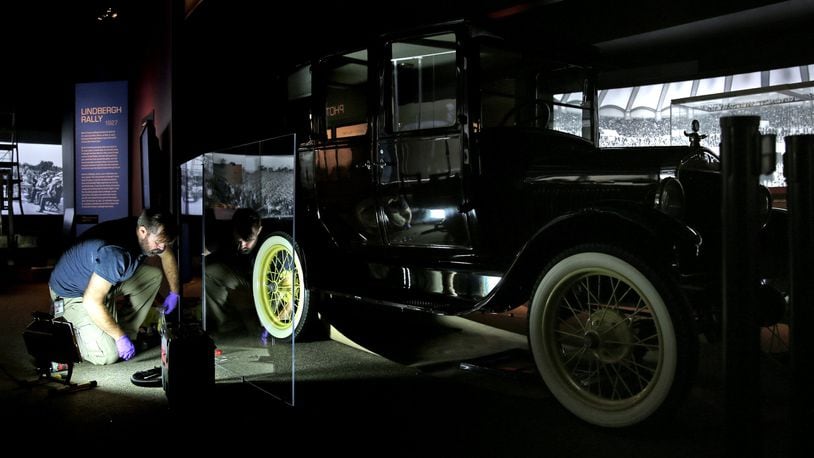But there’s also the streetcars, train and people walking across the Eads Bridge in a giant photo of an early 20th century St. Louis riverfront. The bigger story: Those things present the bridge as the city’s first significant connection to the east.
“Panoramas of the City,” on view through Aug. 12 at the Missouri History Museum in St. Louis’ Forest Park, explores the city’s history from 1900 to 1950 through panoramic photographs. Seven images are blown up to life-size on backlit screens, and more than 60 others are throughout the exhibit.
Objects on display complement the oversize photos. A green seat from Sportsman’s Park accompanies an image of a 1941 Negro Leagues game there. A Veiled Prophet queen’s gown with a 10-foot train stands with a photo of the 1937 Veiled Prophet ball. And a 1927 Ford Model T is parked with one seen in a photo of tornado destruction in St. Louis that year.
“We’ve positioned ourselves to ask about St. Louis history in new ways,” says Adam Kloppe, a public historian at the museum and the head writer and researcher behind the exhibit.
He cited “A Walk in 1875 St. Louis,” the museum’s recent popular exhibit that closely examined life during a single year in the city, and the current exhibit “#1 in Civil Rights,” which explores the role of St. Louis in the black civil rights struggle.
“We asked ourselves, ‘How does St. Louis history look if we only look at these large-format, amazing historical photographs?’ ”
Kloppe and others searched through hundreds of panoramic photos in museum archives and from other institutions such as the Cardinals, Jefferson Barracks and the Mercantile Library. They came up with a cross-section of images showing a broad local history — including a photo of a meeting of the League of Struggle for Negro Rights in fall of 1930.
In spring of that year, six Communist activists had been arrested in Atlanta and faced the death penalty for distributing anti-lynching literature. One leaflet that got them in particular trouble showed a black man and a white man shaking hands. When Kloppe examined the St. Louis photo, which showed men holding signs demanding the release of the Atlanta six, he spotted a black man and a white man kneeling at the front of the group, shaking hands.
“This is a very charged political statement to be making in this photo,” Kloppe says.
The exhibit also explores panoramic photography, which gained popularity well before it became just another smartphone option. Photographers often got big groups to pose in a curved line to minimize distortions, or they sometimes jumped to get in shots at each end of the photo.
The exhibit displays three different panoramic cameras and biographies of four photographers, including the first one hired by a St. Louis newspaper: the Post-Dispatch’s Garnett Palfrey. He took several iconic photos of St. Louis and also took one of President William Howard Taft in 1908 that Taft later praised as his “favorite snapshot.” (The photo was not a panorama.)
The exhibit has an interactive component: The backlit screens displaying the giant panoramas are curved, partly to minimize distortions but also to allow visitors to immerse themselves in the scenes. Computer monitors also let visitors “vote” in the 1920 election, look up stats of the Negro Leagues players seen in the Sportsman’s Park photo and zoom to explore a detailed map of the 1927 tornado destruction.
The Missouri History Museum is still seeking community submissions for the exhibit.
Kloppe says the exhibition has piqued interest among other museum staffers, who are inquiring about using panoramic photos for their own projects and future exhibits. He thinks panoramas are a unique choice.
“I think it’s presented in such a breathtaking way, in a way you’ve never seen photographs before and never seen St. Louis history before,” he says. “I think the way they are presented really puts you in that moment in a way that a regular photograph can’t.”
———
'Panoramas of the City'
When: Through Aug. 12
Where: Missouri History Museum, 5700 Lindell Blvd., Forest Park
How much: Free
More info: mohistory.org
About the Author
